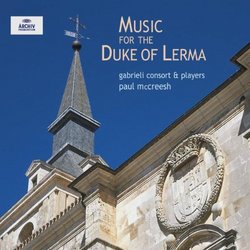| All Artists: Spanish Anonymous, Antonio de Cabezon, Gregorian Chant, Mateo Romero, Juan de Urrede, Tomas Luis de Victoria, Alonso Lobo, Philippe Rogier, Francisco Guerrero, Nicolas Gombert, Paul McCreesh, Timothy Roberts, James Johnstone Title: Music for the Duke of Lerma Members Wishing: 0 Total Copies: 0 Label: Archiv Produktion Release Date: 6/11/2002 Genres: Special Interest, Classical Styles: Opera & Classical Vocal, Chamber Music, Historical Periods, Baroque (c.1600-1750), Classical (c.1770-1830), Early Music Number of Discs: 2 SwapaCD Credits: 2 UPC: 028947169420 |
Search - Spanish Anonymous, Antonio de Cabezon, Gregorian Chant :: Music for the Duke of Lerma
 | Spanish Anonymous, Antonio de Cabezon, Gregorian Chant Music for the Duke of Lerma Genres: Special Interest, Classical
|
Larger Image |
CD Details |
CD ReviewsAn event 08/21/2002 (5 out of 5 stars) "McCreesh and his Gabrieli consort & Players has done a marvelous record again. I must say that I really like (and admire) McCreesh way of bringing life to "odd" rare stuff like this.This is something rare, personal and it must have be a lot of hard work with this. The old church organs (two of them) and other old period instruments give this an extra dimension and singers are at top level. This is spanish medivial/rennaisance (looking a bit forward to early Baroque) at its best and an event.It probably costs a lot to do something like this (research) and this package is well worth its price, even if last disc only contains ca 40 minutes of music (first disc has ca 72 minutes of music), because it comes with a nice, beutiful, informative booklet, great well engineered church sound and lots of good, great choral singing and music." A re-enactment for an infamous Duke... ewomack | MN USA | 12/17/2005 (5 out of 5 stars) "The Duke of Lerma's reputation hasn't aged well. Accused of bankrupting the Spanish Empire's banks, reducing the army and navy to a paltry shadow of their former selves, and miscalculating the horrendous economic effects of exiling thousands of moriscos (Christianized Moors) from Spain, biographies of the Duke often contain numerous less than complimentary passages. King Phillip III took the Duke under his wing and was subsequently treated to events of great religious splendor (allegedly to keep the Duke in the crown's favor as his reputation amongst the nobles melted like wax in a furnace; even the Duke's own son joined the plot against him).
The music on this CD attempts to recreate one such elaborate event. The Duke hosted Phillip III in Lerma in 1617, for the last time before the Duke's fall from favor, to a spectacle of theater, music, games, and religious ceremonies. At San Pedro church the King was treated to a lavish performance of First Vespers and Salve Service. And to this very church in Northern Spain Paul McCreesh and Company set out on their mission to reenact this same service. The results were incredible. If the Duke wanted to curry the pious King's favor, he could not have chosen more inspiring and exhaulting music with which to do so. Mateo Romero's "Dixit Dominus a 16" provides two unbelievably moving creshendoes at the piece's end (though some doubt remains as to whether the piece actually appeared in the service). Tomás Luis de Victoria's "Magnificant a 12" provides eleven minutes of musical ecstasy. The track following it, Alonso Lobo's "Antiphona ad Magnificant" and Victoria's "Salve Regina a 8" provide the choral highlights of the disc. They may induce swooning. And these tracks only represent the highlights of the disc. Nearly every minute of music stands out on its own, particularly the choral pieces. Also, the four hundred year old organ of San Pedro church managed to hold together for this recording. Altogether, the ambience of the on site recording, the sonorous choirs, the amazing performances of all the musicians, and the wonderful gritty sound of the original organ all meld together in an amazing combination that would probably cause anyone to re-evaluate the historically maligned Duke (but they would come to their senses after reading his biography, of course; but it apparently worked on Phillip III). Regardless of the historical statuses of the Duke or Phillip III this CD represents a great example of beautiful and moving early seventeeth century music. Any fan of "early" music will revel in this disc through repeated listenings. The tracks mentioned above are worth the price of admission alone, but the totality of both CDs (comprising an hour and a half of music) won't dissapoint. Not only that, the 84-page booklet contains voluminous background information, photographs (including the famous Rubens equestrian portrait of the Duke from 1603), and all of the lyrics in French, German, Spanish, and English. The infamous Duke of Lerma (Fransisco Gómez de Sandoval y Rojas) may or may not be worthy of such a musical tribute some four hundred years after his controversial reign, but McCreesh and the Gabrieli Consort and Players put on such a spectacular performance that the exploits of the Duke (who, despite everything, also managed to become a Cardinal in 1618) fall nearly completely into the shadows. At least the Duke had great taste in music." |

 Track Listings (28) - Disc #1
Track Listings (28) - Disc #1